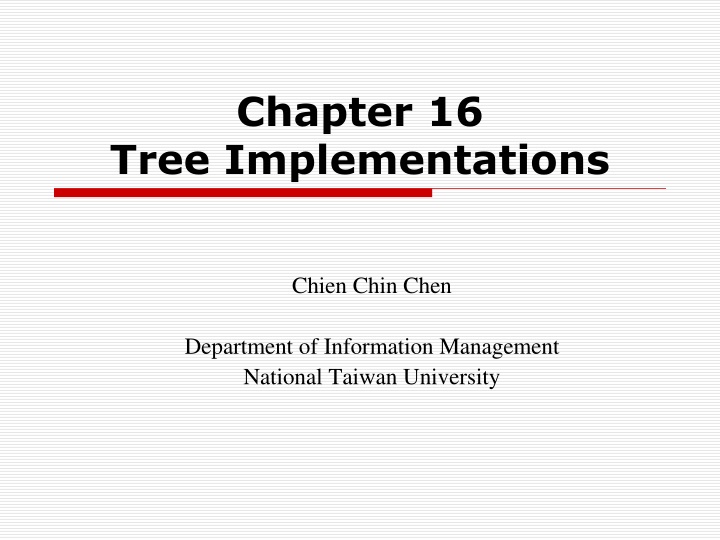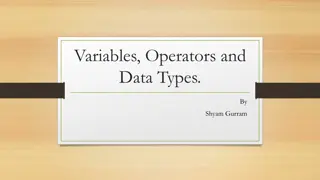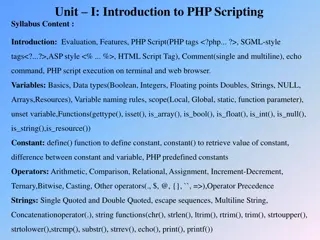
Tree Implementations Overview at National Taiwan University
Explore different implementations of binary trees at National Taiwan University, including array-based and link-based representations. Learn how nodes are structured in C++ classes, and understand the concepts behind managing available nodes in tree structures.
Download Presentation

Please find below an Image/Link to download the presentation.
The content on the website is provided AS IS for your information and personal use only. It may not be sold, licensed, or shared on other websites without obtaining consent from the author. If you encounter any issues during the download, it is possible that the publisher has removed the file from their server.
You are allowed to download the files provided on this website for personal or commercial use, subject to the condition that they are used lawfully. All files are the property of their respective owners.
The content on the website is provided AS IS for your information and personal use only. It may not be sold, licensed, or shared on other websites without obtaining consent from the author.
E N D
Presentation Transcript
Chapter 16 Tree Implementations Chien Chin Chen Department of Information Management National Taiwan University
The Nodes in a Binary Tree The first step is to choose a data structure to represent nodes. Since each node must contain both dataand pointers to the node s children, it is natural to make each node an object!! Thus, we will use a C++ class to define the nodes in the tree. If we place these nodes in an array, the pointers in the nodes are array indices. If the nodes are a part of a linked chain, we use C++ pointers to link them together. 2
An Array-Based Representation (1/3) An array-based implementation of a tree uses an array of nodes, so a class of such trees could have the following data members: TreeNode<ItemType> tree[MAX_NODES]; // array of tree nodes int root; // index of root int free; // index of free list rootis an index to the tree s root node within the array tree. If the tree is empty, root is -1. As the tree changes due to insertions and removals, its nodes may not be in contiguous elements of the array!! You have to establish a collection of available nodes, which is called a free list. free is the index to the first node in the free list. 3
An Array-Based Representation (2/3) Let s name our class of nodes TreeNode. Here, we focus on binary tree!! The class TreeNode for an array-based implement of the ADT binary tree Template<class ItemType> class TreeNode { private: ItemType item; int leftChild; // index to left child int rightChild; // index to right child public: TreeNode(); TreeNode(const ItemType &nodeItem, int left, int right); ... }; // end Tree Node -1 if a node has no left/right child // data portion 4
An Array-Based Representation (3/3) free is the index of the first node in the free list, but the next available node is not necessarily at index free + 1!! We link the available nodes by making the rightChild member of each node be the index of the next node in the free list. 5
A Link-Based Representation (1/3) The most common way of implementing a tree is to use C++ pointers to link the nodes in the tree. Template<class ItemType> class BinaryNode { private: TreeItemType item; BinaryNode<ItemType>* leftChildPtr; // pointer to left child BinaryNode<ItemType>* rightChildPtr;// pointer to right child // data portion public: BinaryNode(); BinaryNode(const ItemType& anItem); BinaryNode(const ItemType& anItem, BinaryNode<ItemType>* leftPtr, BinaryNode<ItemType>* rightPtr); 6
A Link-Based Representation (2/3) void setItem(const ItemType& anItem); ItemType getItem() const; bool isLeaf() const; BinaryNode<ItemType>* getLeftChildPtr() const; BinaryNode<ItemType>* getRightChildPtr() const; void setLeftChildPtr(BinaryNode<ItemType>* leftPtr); void setRightChildPtr(BinaryNode<ItemType>* rightPtr); }; // end BinaryNode 7
A Link-Based Representation (3/3) A class of link-based binary trees will declare one data member: A pointer rootPtr points to the tree s root. If the tree is empty, rootPtr contains nullptr. rootPtr->getLeftChildPtr() points to the root of the left subtree. rootPtr->getRightChildPtr() points to the root of the right subtree. If either of these subtrees is empty, the pointer to it would be nullptr. 8
A Link-Based Implementation of the ADT Binary Tree (1/13) The following is the header file of the class BinaryNodeTree. The protected methods called by the public methods to perform their operations recursively. These methods require pointers (implementation details) as arguments. As such, they should not be public and available to clients of the class. template<class ItemType> class BinaryNodeTree : public BinaryTreeInterface<ItemType> { private: BinaryNode<ItemType>* rootPtr; protected: int getHeightHelper(BinaryNode<ItemType>* subTreePtr) const; int getNumberOfNodesHelper(BinaryNode<ItemType>* subTreePtr) const; ... 9
A Link-Based Implementation of the ADT Binary Tree (2/13) The public section declares constructors, allowing a client to define binary trees in a variety of circumstances: That is empty From data for its root, which is its only node From data for its root and form its two subtrees public: //------------------------------------------------------------ // Constructor and Destructor Section. //------------------------------------------------------------ BinaryNodeTree(); BinaryNodeTree(const ItemType& rootItem); BinaryNodeTree(const ItemType& rootItem, const BinaryNodeTree<ItemType>* leftTreePtr, const BinaryNodeTree<ItemType>* rightTreePtr); BinaryNodeTree(const BinaryNodeTree<ItemType>& tree); virtual ~BinaryNodeTree(); copy constructor 10
A Link-Based Implementation of the ADT Binary Tree (3/13) For example, the following statements invoke these three constructors: BinaryNodeTree<string> tree1; BinaryNodeTree<string>* tree2Ptr = new BinaryNodeTree<string>( A ); BinaryNodeTree<string>* tree3Ptr = new BinaryNodeTree<string>( B ); BinaryNodeTree<string>* tree4Ptr = new BinaryNodeTree<string>( C , tree1 is an empty binary tree; tree2Ptr and tree3Ptr each point to binary trees that have only a root node. tree4Ptrpoints to a binary tree whose root contains C and has subtrees pointed to by tree2Ptr and tree3Ptr. tree2Ptr, tree3Ptr); 11
A Link-Based Implementation of the ADT Binary Tree (4/13) The public methods inherited from BinaryTreeInterface. //------------------------------------------------------------ // Public BinaryTreeInterface Methods Section. //------------------------------------------------------------ bool isEmpty() const; int getHeight() const; int getNumberOfNodes() const; ItemType getRootData() const throw(PrecondViolatedExcep); void setRootData(const ItemType& newData); bool add(const ItemType& newData); // Adds a node bool remove(const ItemType& data); // Removes a node void clear(); ItemType getEntry(const ItemType& anEntry) const throw(NotFoundException); bool contains(const ItemType& anEntry) const; 12
A Link-Based Implementation of the ADT Binary Tree (5/13) The traversal methods inherited from BinaryTreeInterface. //------------------------------------------------------------ // Public Traversals Section. //------------------------------------------------------------ void preorderTraverse(void visit(ItemType&)) const; void inorderTraverse(void visit(ItemType&)) const; void postorderTraverse(void visit(ItemType&)) const; //------------------------------------------------------------ // Overloaded Operator Section. //------------------------------------------------------------ BinaryNodeTree& operator=(const BinaryNodeTree& rightHandSide); }; // end BinaryNodeTree 13
A Link-Based Implementation of the ADT Binary Tree (6/13) Here, we examine the most significant methods: The constructors: template<class ItemType> BinaryNodeTree<ItemType>::BinaryNodeTree() : rootPtr(nullptr) { } // end default constructor template<class ItemType> BinaryNodeTree<ItemType>::BinaryNodeTree(const ItemType& rootItem) { rootPtr = new BinaryNode<ItemType>(rootItem, nullptr, nullptr); } // end constructor template<class ItemType> BinaryNodeTree<ItemType>::BinaryNodeTree(const ItemType& rootItem, const BinaryNodeTree<ItemType>* leftTreePtr, const BinaryNodeTree<ItemType>* rightTreePtr) { rootPtr = new BinaryNode<ItemType>(rootItem, copyTree(leftTreePtr->rootPtr), copyTree(rightTreePtr->rootPtr)); } // end constructor 14
A Link-Based Implementation of the ADT Binary Tree (7/13) The protected method copyTree uses a recursive preorder traversal to copy each node in the tree. template<class ItemType> BinaryNode<ItemType>* BinaryNodeTree<ItemType>:: copyTree(const BinaryNode<ItemType>* treePtr) const { BinaryNode<ItemType>* newTreePtr = nullptr; // Copy tree nodes during a preorder traversal if (treePtr != nullptr) { // Copy node newTreePtr = new BinaryNode<ItemType>(treePtr->getItem(), nullptr, nullptr); newTreePtr->setLeftChildPtr(copyTree(treePtr->getLeftChildPtr())); newTreePtr->setRightChildPtr(copyTree(treePtr->getRightChildPtr())); } // end if return newTreePtr; } // end copyTree 15
A Link-Based Implementation of the ADT Binary Tree (8/13) The copy constructor then looks like this: template<class ItemType> BinaryNodeTree<ItemType>::BinaryNodeTree(const BinaryNodeTree<ItemType>& tree) { rootPtr = copyTree(tree.rootPtr); } // end copy constructor Erratum!! 16
A Link-Based Implementation of the ADT Binary Tree (9/13) The destructor calls destroyTree(rootPtr) to delete each node in the tree in a recursive postorder manner. template<class ItemType> void BinaryNodeTree<ItemType>::destroyTree(BinaryNode<ItemType>* subTreePtr) { if (subTreePtr != nullptr) { destroyTree (subTreePtr->getLeftChildPtr()); destroyTree (subTreePtr->getRightChildPtr()); delete subTreePtr; } // end if } // end destroyTree The destructor then only needs to make the call destroyTree(rootPtr). template<class ItemType> BinaryNodeTree<ItemType>::~BinaryNodeTree() { destroyTree(rootPtr); } // end destructor 17
A Link-Based Implementation of the ADT Binary Tree (10/13) Another recursive example: template<class ItemType> int BinaryNodeTree<ItemType>::getHeightHelper(BinaryNode<ItemType>* subTreePtr) const { if (subTreePtr == nullptr) return 0; else return 1 + max(getHeightHelper(subTreePtr->getLeftChildPtr()), getHeightHelper(subTreePtr->getRightChildPtr())); } // end getHeightHelper template<class ItemType> int BinaryNodeTree<ItemType>::getHeight() const { return getHeightHelper(rootPtr); } // end getHeight 18
A Link-Based Implementation of the ADT Binary Tree (11/13) The method Add: The specification of the public method add does not indicate where the new node should be in the tree. We have flexibility in how we define the method. Let s add the new node so that the resulting tree is balanced. template<class ItemType> bool BinaryNodeTree<ItemType>::add(const ItemType& newData) { BinaryNode<ItemType>* newNodePtr = new BinaryNode<ItemType>(newData); rootPtr = balancedAdd(rootPtr, newNodePtr); return true; } // end add 19
A Link-Based Implementation of the ADT Binary Tree (12/13) template<class ItemType> BinaryNode<ItemType>* BinaryNodeTree<ItemType>::balancedAdd( BinaryNode<ItemType>* subTreePtr, BinaryNode<ItemType>* newNodePtr) { if (subTreePtr == nullptr) return newNodePtr; else { BinaryNode<ItemType>* leftPtr = subTreePtr->getLeftChildPtr(); BinaryNode<ItemType>* rightPtr = subTreePtr->getRightChildPtr(); rightPtr = balancedAdd(rightPtr, newNodePtr); subTreePtr->setRightChildPtr(rightPtr); } else { leftPtr = balancedAdd(leftPtr, newNodePtr); subTreePtr->setLeftChildPtr(leftPtr); } if (getHeightHelper(leftPtr) > getHeightHelper(rightPtr)) { return subTreePtr; } } 20
A Link-Based Implementation of the ADT Binary Tree (13/13) The traversals: Since the traversal are recursive (using pointers implementation details), the public traversal methods each calls a protected method that performs the actual recursion. template<class ItemType> void BinaryNodeTree<ItemType>::inorder( { if (treePtr != nullptr) { inorder(visit, treePtr->getLeftChildPtr()); ItemType theItem = treePtr->getItem(); visit(theItem); inorder(visit, treePtr->getRightChildPtr()); } void visit(ItemType&), BinaryNode<ItemType>* treePtr) const function as a parameter template<class ItemType> void BinaryNodeTree<ItemType>::inorderTraverse(void visit(ItemType&)) const { inorder(visit,rootPtr); } 21
A Link-Based Implementation of the ADT Binary Search Tree (1/20) Since a binary search tree is a binary tree, its implementation can use the same node objects as for a binary-tree implementation. We will use the class BinaryNode. We assume that the data items in the binary search tree are unique!! The recursive search algorithm is the basis of the insertion, removal, and retrieval operations on a binary search tree. 22
A Link-Based Implementation of the ADT Binary Search Tree (2/20) Adding a new entry: You insert a new entry into a binary search tree in the same place that the search algorithm would look for it!! Because searching for an entry that is not in the binary search tree always ends at an empty subtree YOU ALWAYS INSERT A NEW ITEM AS A NEW LEAF!! Adding a leaf requires only a change of the appropriate pointer in the parent. 23
A Link-Based Implementation of the ADT Binary Search Tree (3/20) template<class ItemType> int BinarySearchTree<ItemType>::add(const ItemType& newData) { BinaryNode<ItemType>* newNodePtr = new BinaryNode<ItemType>(newData); rootPtr = insertInorder(rootPtr, newNodePtr); } // end add return true; // pseudocode of insertInorder insertInorder(subTreePtr:: BinaryNodePointer, newNodePtr: BinaryNodePointer): BinaryNodePointer if (subTreePtr is nulptr) return newNodePtr else if (subTreePtr->getItem() > newNodePtr->getItem()) { tempPtr = insertInorder(subTreePtr->getLeftChildPtr(), newNodePtr) subTreePtr->setLeftChildPtr(tempPtr) } else { tempPtr = insertInorder(subTreePtr->getRightChildPtr(), newNodePtr) subTreePtr->setRightChildPtr(tempPtr) } return subTreePtr 24
A Link-Based Implementation of the ADT Binary Search Tree (4/20) Removing an entry: Is more complicated than adding. First, you use the search algorithm to locate the specified item. If it is found, you must remove it from the tree. Assuming that removeValue locates the target in a particular node N. 25
A Link-Based Implementation of the ADT Binary Search Tree (5/20) removeValue(subTreePtr: BinaryNodePointer, target: ItemType, success: Boolean&): BinaryNodePointer if(subTreePtr == nullptr) { success = false return nullptr } else if (subTreePtr->getItem() == target) { subTreePtr = removeNode(subTreePtr) success = true return subTreePtr } else if (subTreePtr->getItem() > target) { tempPtr = removeValue(subTreePtr->getLeftChildPtr(), target, success) subTreePtr->setLeftChildPtr(tempPtr) return subTreePtr } else { tempPtr = removeValue(subTreePtr->getRightChildPtr(), target, success) subTreePtr->setRightChildPtr(tempPtr) return subTreePtr } 26
A Link-Based Implementation of the ADT Binary Search Tree (6/20) The essential task is to remove the target N from the tree (removeNode). There are three cases to consider: N is a leaf N has only one child N has two children Case 1 is the easiest. You need only set the pointer in its parent to nullptr. 27
A Link-Based Implementation of the ADT Binary Search Tree (7/20) Case 2 is a bit more involved. If N has only one child: N has only a left child N has only a right child The two possibilities are symmetrical, so we illustrate the solution for a left child. 28
A Link-Based Implementation of the ADT Binary Search Tree (8/20) Let L take the place of N as one of P s children Yes, the binary search tree property is preserved!! Does this adoption preserve the binary search tree property? 29
A Link-Based Implementation of the ADT Binary Search Tree (9/20) Case 3 is the most difficult case. N s parent has room for only one N s children as a replacement for N!! 30
A Link-Based Implementation of the ADT Binary Search Tree (10/20) In fact, you can find another node that is easier to delete and delete it instead of N. This strategy may sound like cheating But remember that the client expects only a certain entry to be removed from the ADT. It has no right, because of the WALL between the program and the ADT implementation, to expect a particular node in the tree to be deleted. 31
A Link-Based Implementation of the ADT Binary Search Tree (11/20) Removing strategy: 1. Locate another node M that is easier to remove from the tree than the node N. 2. Copy the item that is in M to N, thus effectively removing from the tree the item originally in N. 3. Remove the node M from the tree. But what kind of node M is easier to remove?? 32
A Link-Based Implementation of the ADT Binary Search Tree (12/20) M should have a single child or no children. After replacing N by M, you must also preserve the tree s status as a binary search tree!! 33
A Link-Based Implementation of the ADT Binary Search Tree (13/20) There are two suitable possibilities for the replacement. You can copy into N the item that is immediately before/afterN in the sorted order. Suppose that we decide to use the node y whose entry comes immediately after N s entry x. This entry is called x s inorder successor. 34
A Link-Based Implementation of the ADT Binary Search Tree (14/20) How can you locate this node? Because N has two children, the inorder successor is in the leftmost node of N s right subtree. You follow N s right-child pointer to its right childC(must be present). Then, you descend the tree rooted at C by taking left branchesat each node until you encounter a node S with no left child. Copy the item in S into N. REMOVE S!! Because S has no left child you can remove S from the tree as one of the two easy cases. 35
A Link-Based Implementation of the ADT Binary Search Tree (15/20) Pseudocode of removeNode removeNode(N:: BinaryNode) if (N is a leaf) Remove N from the tree else if (N has only one child C) { if (N was a left child of its parent P) Make C the left child of P else Make C the right child of P } else { Find S, the node that contains N s inorder successor Copy the item from node S into node N Remove S from the tree by using the previous technique for a leaf or a node with one child } 36
A Link-Based Implementation of the ADT Binary Search Tree (16/20) removeNode(nodePtr:: BinaryNodePointer): BinaryNodePointer if (N is a leaf) { delete nodePtr nodePtr = nullptr return nodePtr } else if (N has only one child C) { if (C is the left child) nodeToConnectPtr = nodePtr->getLeftChildPtr() else nodeToConnectPtr = nodePtr->getRightChildPtr() delete nodePtr nodePtr = nullptr return nodeToConnectPtr Erratum!! } 37
A Link-Based Implementation of the ADT Binary Search Tree (17/20) else { } tempPtr = removeLeftmostNode(nodePtr->getRightChildPtr(), newNodeValue) nodePtr->setRightChildPtr(tempPtr) nodePtr->setItem(newNodeValue) return nodePtr 38
A Link-Based Implementation of the ADT Binary Search Tree (18/20) removeLeftmostNode(nodePtr:: BinaryNodePointer, inorderSuccessor: ItemType&): BinaryNodePointer if (nodePtr->getLeftChildPtr() == nullptr) { inorderSuccessor = nodePtr->getItem() return removeNode(nodePtr) } else { tempPtr = removeLeftmostNode(nodePtr->getLeftChildPtr(),inorderSuccesssor) nodePtr->setLeftChildPtr(tempPtr) return nodePtr } Erratum!! 39
A Link-Based Implementation of the ADT Binary Search Tree (19/20) The public method remove: remove (target: ItemType): boolean success = false rootPtr = removeValue(rootPtr, target, success) return success 40
A Link-Based Implementation of the ADT Binary Search Tree (20/20) Retrieving an entry getEntry: Call findNode to recursively checks whether the desired target is in a binary search tree. It checks the return value, and returns the desired target or throws an exception findNode (subTreePtr: BinaryNodePointer, target: itemType): BinaryNodePointer return findNode(subTreePtr->getRightChildPtr(), target) if(subTreePtr == nullPtr) return nullptr else if (subTreePtr->getItem()== target) return subTreePtr; else if (subTreePtr->getItem() >target) return findNode(subTreePtr->getLeftChildPtr(), target) else 41
Saving a Binary Search in a File (1/6) Saving a binary search tree and then restoring it to its original shape: Uses preorder traversal to save the tree to a file. 60 60 20 70 20 70 save restore 10 40 10 40 30 50 30 50 Preorder: 60 20 10 40 30 50 70 42
Saving a Binary Search in a File (2/6) Saving a binary search tree and then restoring it to a balanced shape: Uses inorder traversal to save the tree to a file. To make the data sorted. To restore, need the number of nodes in the tree. Can determine the middle item and, in turn, the number of nodes in the left and right subtrees of the tree s root. 43
Saving a Binary Search in a File (3/6) Restoring a full binary search tree: You can use the following recursive algorithm to create a full binary search tree with n nodes (provided you either know or can determine n beforehand). readFullTree (treePtr: BinaryNodePointer, n: integer): BinaryNodePointer if (n > 0) { treePtr = pointer to new node with nullptr as its child pointers // Construct the left subtree leftPtr = readFullTree(treePtr->getLeftChildPtr(), n / 2) treePtr->setLeftChildPtr(leftPtr) Erratum!! // Get the root rootItem = next item from file treePtr->setItem(rootItem) // Construct the right subtree rightPtr = readFullTree(treePtr->getRightChildPtr(), n / 2) treePtr->setRightChildPtr(rightPtr) return treePtr } else return nullptr 44
Saving a Binary Search in a File (4/6) If the tree to be restored is not full: The first thing that comes to mind is that the resorted tree should be complete. But you care only abut minimizing the height of the restored tree. It does not matter where the nodes on the last level go. 45
Saving a Binary Search in a File (5/6) The method readFullTree is correct even if the tree is not full!! However, you have to be a bit careful when computing the sizes of the left and right subtrees of the tree s root. If n is odd, both subtrees are of size n/2. If n is even, you have to deal with the fact that one subtree will have one more node than the other. In this case, we put the extra node in the left subtree. 46
Saving a Binary Search in a File (6/6) readTree(treePtr: BinaryNodePointer, n: integer): BinaryNodePointer if (n > 0) { treePtr = pointer to new node with nullptr as its child pointers // Construct the left subtree leftPtr = readTree(treePtr->getLeftChildPtr(), n / 2) treePtr->setLeftChildPtr(leftPtr) // Get the root rootItem = next item from file treePtr->setItem(rootItem) Erratum!! // Construct the right subtree rightPtr = readTree(treePtr->getRightChildPtr(), (n - 1) / 2) treePtr->setRightChildPtr(rightPtr) return treePtr } else return nullptr 47
Treesort (1/2) Treesort Uses the ADT binary search tree to sort an array of integers into ascending order. treeSort(anArray: array, n: integer) Insert anArray s entries into a binary search tree bst Traverse bst in inorder. As you visit bst s nodes, copy their data items into successive locations of anArray 48
Treesort (2/2) Analysis: Insertion: Each insertion into a binary search tree requires O(logn) operations in the average case. And O(n) operations in the worst case. Thus, n-node insertions require O(nlogn) operations in average case, and O(n2) operations in the worst case. The inroder traversal: O(n) in all cases. Sum up: Average case: O(nlogn) Worst case: O(n2) 49
General Trees (1/2) Each node can have an arbitrary number of children. A binary tree can represent a general tree. Each node has two pointers: The left pointer points to the node s oldest (first) child. The right pointer points to the node s next sibling. 50


![Stakeholders' Responses to National Health Insurance Bill [B.11B-2019]: Overview](/thumb/69945/stakeholders-responses-to-national-health-insurance-bill-b-11b-2019-overview.jpg)



















